Abstract
Experiments indicate that the thermochemical decomposition of composite materials is sensitive to small periodic perturbations in the external flux and to wall vibrations. Stable, unstable, and self-oscillatory combustion regimes are found for these materials, and limiting conditions for the binder concentration and vibration intensity are determined for which it is possible to reduce thermal loads to the wall and control heat and mass transfer. Monostationarty and stability boundaries are constructed and the results are compared with theory.
Similar content being viewed by others
References
B. V. Raushenbakh,Oscillatory Combustion [in Russian], Fizmatgiz, Moscow (1961).
D. A. Frank-Kamenetskii,Diffusion and Heat Transfer in Chemical Kinetics [in Russian], Nauka, Moscow (1987).
A. N. Golovanov, “Effect of vibration on the combustion of several carbon-graphite materials,”Fiz. Goreniya Vzryva,24, No. 4, 69–71 (1988).
A. N. Golovanov, “Hydrodynamic and thermal characteristics of porous cooling systems in the presence of small periodic perturbations,”Inzh.-Fiz. Zh.,66, No. 6, 695–701 (1994).
A. M. Grishin and V. M. Fomin,Adjoint and Nonstationary Problems in the Mechanics of Reactive Media [in Russian], Nauka, Novosibirsk (1984).
E. S. Platunov, (ed.),Thermophysical Measurements and Apparatus [in Russian], Mashinostroenie, Leningrad (1986).
Ya. A. Belikhmaer, N. M. Smolyaninova, and S. I. Smolyaninov,Experimental Technique: Manual [in Russian], Izd. Tomsk Politekh. Inst., Tomsk (1983).
S. P. Sinitsyn, “Solution of the inverse problem of the pyrolysis of composite polymer materials in a two-stage kinetic scheme,”Fiz. Goreniya Vzryva,23, No. 4, 48–56 (1987).
W. Wendtland,Thermal Methods of Analysis, Wiley, New York (1974).
G. N. Isakov,Modelling Nonstationary Heat and Mass Transfer Processes and Ignition in Reactive Media [in Russian], Izd. Tomsk. Univ., Tomsk (1991).
V. M. Agranat and A. M. Grishin, “Qualitative analysis of nonstationary heat and mass transfer in a boundary layer with chemical reactions with intense injection,”Prikl. Mat. Mekh.,42, No. 6, 1056–1067 (1978).
V. M. AgranatAnalytic Studies of Heat and Mass Transfer and Friction in Boundary Layers [in Russian], Izd. Tomsk. Univ., Tomsk (1991).
G. I. Nazarov and V. V. Sushkin,Thermally Stable Plastics: A Handbook [in Russian], Mashinostroenie, Moscow (1980).
D. A. Gubin, “Prediction of nonstationary, heat and mass transfer in reactive systems,” in:Physical and Mathematical Modeling of Thermal and Hydrodynamic Proces: (collected scientific papers) [in Russian], Tomsk. Politekhn. Iniv., Tomsk (1990), pp. 104–109.
E. B. Vol’ter and I. E. Sal’nikov,Operating Stability of Chemical Reactors [in Russian], Khimiya, Moscow (1981).
Yu. V. Polezhaev and F. B. Yurevich,Thermal Protection [in Russian], Energiya, Moscow (1976).
Author information
Authors and Affiliations
Additional information
Translated fromFizika Goreniya i Vzryva, Vol. 35, No. 3, pp. 67–73, May–June 1999.
Rights and permissions
About this article
Cite this article
Golovanov, A.N. Effect of periodic perturbations on the thermal decomposition of some composite materials. Combust Explos Shock Waves 35, 275–280 (1999). https://doi.org/10.1007/BF02674450
Received:
Revised:
Issue Date:
DOI: https://doi.org/10.1007/BF02674450




